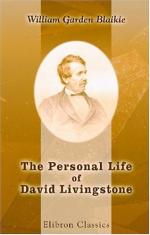Dr. and Mrs. Livingstone sail in the “Pearl”—Characteristic instructions to members of Expedition—Dr. Livingstone conscious of difficult position—Letter to Robert—Sierra Leone—Effects of British Squadron and of Christian Missions—Dr. and Mrs. Moffat at Cape Town—Splendid reception there—Illness of Mrs. Livingstone—She remains behind—The five years of the Expedition—Letter to Mr. James Young—to Dr. Moffat—Kongone entrance to Zambesi—Collision with Naval Officer—Disturbed state of the country—Trip to Kebrabasa Rapids—Dr. Livingstone applies for new steamer—Willing to pay for one himself—Exploration of the Shire—Murchison Cataracts—Extracts from private Journal—Discovery of Lake Shirwa—Correspondence—Letters to Agnes Livingstone—Trip to Tette—Kroomen and two members of Expedition dismissed—Livingstone’s vindication—Discovery of Lake Nyassa—Bright hopes for the future—Idea of a colony—Generosity of Livingstone—Letters to Mr. Maclear, Mr. Young, and Sir Roderick Murchison—His sympathy with the “honest poor”—He hears of the birth of his youngest daughter.
On the 10th March 1858, Dr. Livingstone, accompanied by Mrs. Livingstone, their youngest son, Oswell, and the members of his Expedition, sailed from Liverpool on board Her Majesty’s colonial steamer, the “Pearl,” which carried the sections of the “Ma-Robert,” the steam launch with Mrs. Livingstone’s African name, which was to be permanently used in the exploration of the Zambesi and its tributaries. At starting, the “Pearl” had fine weather and a favorable wind, and quickly ran down the Channel and across the Bay of Biscay. With that business-like precision which characterized him, Livingstone, as soon as sea-sickness was over, had the instructions of the Foreign Office read in presence of all the members of the Expedition, and he afterward wrote out and delivered to each person a specific statement of the duties expected of him.
In these very characteristic papers, it is interesting to observe that his first business was to lay down to each man his specific work, this being done for the purpose of avoiding confusion and collision, acknowledging each man’s gifts, and making him independent in his own sphere. While no pains were to be spared to make the Expedition successful in its scientific and commercial aims, and while, for this purpose, great stress was laid on the subsidiary instructions prepared by Professor Owen, Sir W. Hooker, and Sir R. Murchison, Dr. Livingstone showed still more earnestness in urging duties of a higher class, giving to all the same wise and most Christian counsel to maintain the moral of the Expedition at the highest point, especially in dealing with the natives:




